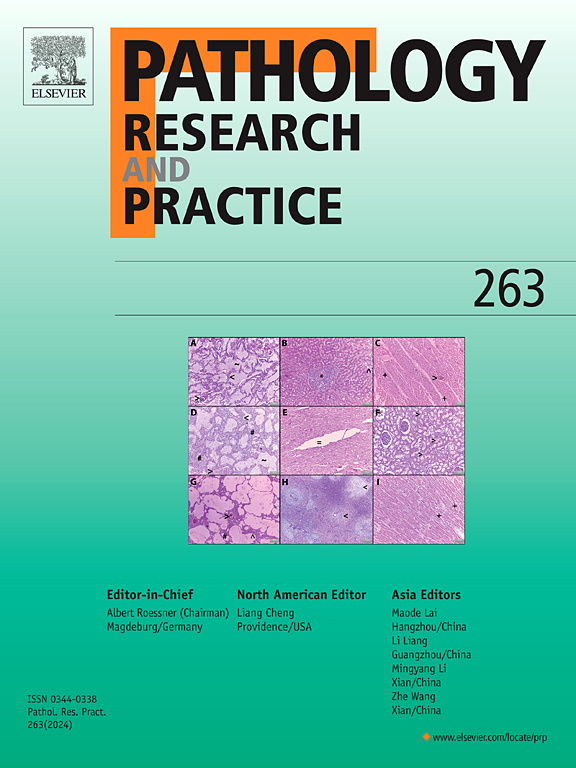布比卡因对甘油致急性肾损伤大鼠心脏组织的影响
IF 3.2
4区 医学
Q2 PATHOLOGY
引用次数: 0
摘要
目的通过TRPM2、HSP70、TLR4、NF-κB、TNF-α等生物标志物,评价布比卡因对急性肾损伤(AKI)的影响。材料与方法将雄性Wistar白化大鼠分为4组,每组7只:对照组、AKI组(甘油致肾损害)、AKI + 组(布比卡因组)、L组(布比卡因单独治疗组)。实验结束时,取肾脏和心脏组织进行组织学分析,取血清样本进行生化分析。测定血清中尿素氮(BUN)、肌酐(Cr)、肌钙蛋白t、肌酸激酶、肌酸激酶- mb和总氧化剂水平。在组织学分析中,通过KIM-1、TNF-α、TRPM2、HSP70、NF-κB和TLR4等参数,通过组织病理学和免疫组织化学方法评估心脏和肾脏组织的变化。结果AKI组血尿素氮(BUN)、肌酐(CR)水平较对照组显著升高(p <; 0.05)。值得注意的是,在AKI + 局麻(L)组中,与AKI组相比,这些水平升高。AKI组肾组织中KIM-1和TNF-α免疫反应性均较对照组显著升高,AKI + L组较AKI组进一步升高。在心脏组织中,AKI + L组TLR4、NF-κB、TNF-α、HSP70、TRPM2的免疫反应性水平较AKI组显著升高(p <; 0.05)。AKI + L组组织病理损伤程度较AKI组更严重(p <; 0.05)。结论布比卡因加重急性肾损伤,导致肾脏功能和心脏组织参数发生明显的组织病理学改变。观察布比卡因可能影响心脏传导,损害心功能,导致KIM-1、TNF- α、TRPM2、HSP70、TLR4、NF-κ b等分子通路的改变。此外,氧化水平和生物标志物水平的增加表明,布比卡因可能诱导氧化应激和炎症,导致肾脏和心脏组织损伤。本文章由计算机程序翻译,如有差异,请以英文原文为准。
Evaluation of the effect of bupivacaine on the heart tissue in rats with glycerol-induced acute kidney injury
Aim
This study aims to evaluate the effects of bupivacaine on acute kidney injury (AKI) through kidney function parameters and cardiac tissue damage via TRPM2, HSP70, TLR4, NF-κB, and TNF-α biomarkers.
Material and method
Male Wistar albino rats were divided into 4 groups, with seven rats in each group: Control group, AKI group (kidney damage induced by glycerol), AKI + L group (group treated with bupivacaine), and L group (group treated with bupivacaine alone). At the end of the experiment, kidney and heart tissues were collected for histological analysis, and serum samples were taken for biochemical analysis. In serum samples, urea nitrogen (BUN), creatinine (Cr), troponin t, Creatine Kinase, Creatine Kinase-MB, and total oxidant levels were measured. In histological analysis, changes in heart and kidney tissues were evaluated histopathologically and immunohistochemically through KIM-1, TNF-α, TRPM2, HSP70, NF-κB, and TLR4 parameters.
Results
In the AKI group, a significant increase in blood urea nitrogen (BUN) and creatinine (CR) levels was observed when compared to the control group (p < 0.05). Notably, in the AKI + Local Anesthetic (L) group, these levels were found to be elevated compared to the AKI group. KIM-1 and TNF-α immunoreactivity in kidney tissue were both significantly elevated in the AKI group compared with the Control group, and further increased in the AKI + L group compared with the AKI group. In heart tissues, significant increases in the immunoreactivity levels of TLR4, NF-κB, TNF-α, HSP70, and TRPM2 were observed in the AKI + L group relative to the AKI group (p < 0.05). Moreover, in the AKI + L group, the extent of histopathological damage was found to be more severe compared to the AKI group (p < 0.05).
Conclusion
This study demonstrates that bupivacaine exacerbates acute kidney injury and leads to significant histopathological changes in kidney function and heart tissue parameters. It was observed that bupivacaine might affect cardiac conduction, impairing heart functions, and lead to changes in molecular pathways such as KIM-1, TNF- α, TRPM2, HSP70, TLR4, and NF-κB. Furthermore, the increase of oxidant levels and biomarker levels suggest that bupivacaine may induce oxidative stress and inflammation, leading to damage in both kidney and heart tissues.
求助全文
通过发布文献求助,成功后即可免费获取论文全文。
去求助
来源期刊
CiteScore
5.00
自引率
3.60%
发文量
405
审稿时长
24 days
期刊介绍:
Pathology, Research and Practice provides accessible coverage of the most recent developments across the entire field of pathology: Reviews focus on recent progress in pathology, while Comments look at interesting current problems and at hypotheses for future developments in pathology. Original Papers present novel findings on all aspects of general, anatomic and molecular pathology. Rapid Communications inform readers on preliminary findings that may be relevant for further studies and need to be communicated quickly. Teaching Cases look at new aspects or special diagnostic problems of diseases and at case reports relevant for the pathologist''s practice.

 求助内容:
求助内容: 应助结果提醒方式:
应助结果提醒方式:


